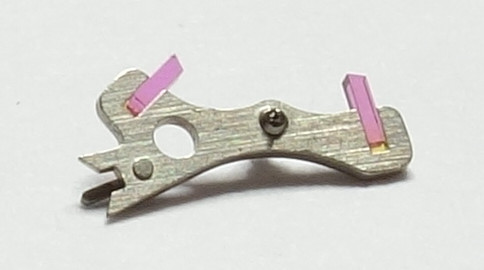Description
The japanese manufacturer Ricoh produced mainly in the 1970ies a number of selfwinding movements, which are mostly unknown in literature and also online.
The 12 3/4 ligne (29mm) selfwinding movement shown here, which has got no date correction pusher, is probably the caliber R20.
As common on most japanese movements, the base plate shows a bare but technically well made construction where all important bearings contain rubies. You also see the reserved space of the metal rim of the oscillating weight and the two pits, which are used for fixating the movement in the case by clamps.
This movement still uses a center minute wheel - a very classical and proven construction, which was technically no longer state of the art in 1970.
As the center minute wheel already implied, the whole gear train does not offer any surprises: With third wheel, center seconds wheel and the escapement wheel it uses the classical gear train.
The Ricoh caliber shown here has got a speciality: A lateral lever with a very short fork:
Not only the shape of the lever is remarkable, it is responsible, that there are no banking pins on the base plate. Instead, the lever has got a hole, into which a single pin from the main plate intervenes and limits the maximum way of the lever:
The pallet lever, which regulates a swiss lever movement, is driven by a two-leg anular balance, which beats still slowly with 18000 A/h and is secured in two Parashock bearings.
The selfwinding module is placed on top and next to the movement bridge and is constructed as a rocking bar changer: The center, ball beared oscillating weight drives the rocking bar changer, which depending on the rotating direction interferes either directly with the next reduction wheel, or with an 1:1 change wheel inbetween. A click spring ensures, that the reduction wheel can only turn in one direction and so wind the mainspring with two additional reduction steps.
On manual winding, the rocking bar changer decouples the oscillating weight.
If you look excatly on the inner side of the selfwinding gear bridgt, you can see the ratchet mechanism, which engages with the first reduction wheel and blocks it, when it tries to turn “backwards”. On top left, you see the axle for the last transmission wheel, which interferes with the ratchet wheel.
As already written, the oscillating weight is ball beared. Its sprocket engages with the rocking bar changer of the selfwinding mechanism.
Except the rocking bar changer and the last, slow turning, transmission wheel, all other wheels of the selfwinding mechanism are ruby-beared.
On the empty dial side you the odd constructed yoke winding system. Its setting lever spring should keep the flying setting lever in position. This one is only beared on its upper side, otherwise, it slips(!) on the dial side into its position, supported by its prolonged arm at 4 o’clock.
On the specimen shown here, this mechanism no longer works, but it is unclear, whether it is just worn out, a bad construction or if some parts are missing.
The calendar mechanism is also an unneccessiary complicated construction: The switching wheel at 12 o’clock has got a moveable mounted finger, which is held in position with a super tiny spring(!). This spring is attached between two micro small holes, one in the finger and the other on the disk, virtually impossible to mount after dissection. On the pro side, this mechanism allowed half-fast correction of the date by turning the hands back and forth a few hours.
The date ring is Der Datumsring lies relatively far inside this movement and compensates its large diameter.
Technical data
| Manufacturer: | Ricoh |
| Caliber: | unknown |
| Size: | 12 3/4''' (measured: 29.0mm) |
| A/h: | 18000 |
| Number of jewels: | 21 |
| Escapement: | Pallet lever |
| Balance types: |
Nickel anular balance |
| Shock protection(s): |
Parashock 2 (Citizen) |
| Balance bearing / direction hairspring: | Counterclockwise |
| Moveable stud: | yes |
| Adjust mechanism: | Hairspring key |
| Construction: |
|
| Construction type: | solid construction |
| Winding mechanism: | yoke winding system |
| Features: |
|
| Inventory number: | 18003 |














